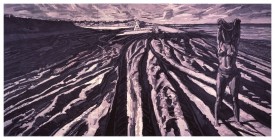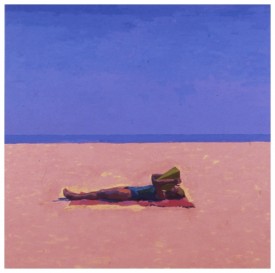Graham Nickson: Light and Geometry at Betty Cuningham Gallery
November 4 to December 22, 2017
15 Rivington Street, between Chrystie Street and Bowery
New York City, bettycuninghamgallery.com

Because our visual culture is supersaturated with representations of all kinds, contemporary figurative artists need to be resourceful to survive. Some do this by appropriating imagery from advertising, while others borrow from old master or modernist art. The paintings and works on paper in this mini-retrospective present a now familiar modernist theme, beach scenes. And so, merely identifying Graham Nickson’s theme may suggest that he is a very traditional artist. As a teacher, I should add, he loves to talk about the importance of drawing; and in this exhibition’s catalogue he discusses the importance of working from direct observation – both, of course, traditional concerns. But look at Bather with Reflector (1982-83), with its dramatic horizontal division, the intensely artificial sky above the sand and reclining bather. Here you see how much Nickson owes to Brice Marden’s monochromes and to the blank colored backgrounds in Alex Katz’s portraits. Observe, too, how Departure (1977-1994), another enormous painting, plays an intensely lit sky against the darkness of the foreground, where the fisherman and beach goers stand. This, too, is a most untraditional composition. Or consider Tracks (1982-91), an enormous near-monochrome in which the tracks in the sands run out to the horizon in a daring perspectival construction. Originally this much-reworked picture was done in full color. A nineteenth-century painter might show this motif from a distance. By taking us close up and eliminating local color, Nickson reveals the strange visual qualities of his tracks. And I love the daring way that the delicious Maine Grey: Yellow Jacket (2017) places the back-turned standing figure in the immediate foreground, presenting another untraditional motif.

Nickson is a very varied painter – and this exhibition provides an effective introduction to the range of his artistic interests. What then links together all of these works is a highly personal, most effective vision of the artist’s goals. He has said: “The entire process of creating art is abstract, but the finished work is a metaphor for the artist’s experience and direct observation of nature.” If I understand him correctly, this statement helps identify the difference between the five paintings in this show and the various smaller watercolors and charcoal drawings. These works on paper are relatively immediate responses to his chosen motifs, while the paintings are more considered developments in which reworking of these products of direct observation is mediated by prolonged reflection. ‘Abstract’ here thus is a shorthand way of identifying his active concern to develop these motifs, in response to his governing aesthetic. This, I think, is why Nickson is not interested in the psychology of the people he depicts – they are just his subjects. And it is what makes the beach such an ideal site for him, because of its location between the urban world of culture and nature. We may enjoy beaches because we think of them as timeless, unspoiled places, but of course they too, as much as the city, are, in part, modernist urban creations – they too thus are artificial. I believe that only a contemporary artist would understand figurative images in these terms. What then seems to me distinctive (and highly original) in Nickson’s art is his passionate pursuit of immediate visual experience. You don’t imagine that he searches the Internet for motifs. In that way, allowing for the qualifications that I have offered, he can be identified as a very belated modernist.


